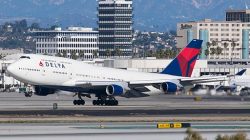Delta’s latest network add between Chicago O’Hare and London Heathrow during the winter period comes as no surprise given the recent launch of its brand new joint-venture agreement with Virgin Atlantic Airways, which came into effect on January 1 of this year. In December 2012, Delta purchased a 49% stake in Virgin from Singapore Airlines, and per the terms of the fully integrated joint venture, both carriers now operate 30+ daily transatlantic flights on a “metal neutral” basis with each sharing the costs and revenues evenly from all joint venture-marketed flights.
The Delta-operated flights will offer daily round-trip services between O’Hare and Heathrow from October 26, 2014 through spring 2015. Virgin Atlantic will then pick-up the services on its own metal through the late spring, summer and early fall months. Currently, Virgin Atlantic flies between London to Chicago, but only on a seaonal basis from early May through late October.
Both the Delta and Virgin Atlantic flights will carry the same flight numbers, VS 39/40 and DL 39/40 during their respected periods of operation. The Delta flights will operate during the winter timeframe adhering to the following schedule:
DL040 ORD1730 – 0735+1LHR 76W D
DL039 LHR0930 – 1245ORD 76W D
Market share to stay at consistent levels between 4 airlines competing on ORDLHR
Virgin has been unsuccessful at serving the Chicago O’Hare market on a year-round basis when demand drops off during the off-peak winter season. In the Chicago to London market, Virgin currently competes against American, United and British Airways, all three of which not only fly this route year round, but also each operate multiple daily frequencies between the two markets.
Data in CAPA OAG charts indicate that between May and October over the past few years, all four carriers offered roughly 17,000 weekly seats between Chicago and London in the summer period. During the winter months, from late October through early April, the numbers drop nearly a third to 12,500 weekly seats. Some of this is caused by Virgin’s seasonal withdrawal from the market, but the remaining three carriers are also privvy to reign in capacity and slash schedules to account for seasonal drops in demand.
Year-round, American offers the largest weekly seating capacity share at approximately 40%, followed next by United at 28%. British Airways comes in third at around 21%, and Virgin comes in last at around 11% (the numbers adjust by increasing a few percentage points per carrier during the slow periods to account for the absence of Virgin).
Virgin Atlantic deploys an Airbus A330/A340 on its daily Chicago route from Heathrow, in a 2-class cabin configuration featuring Upper Class (business) and Economy (Virgin also offers a premium economy class product). In comparison, American operates 3-4 daily services between ORD and LHR, varying between Boeing 777-200ER and 767-300ER equipment. British Airways offers two daily services varying between a Boeing 747-400, 777-300ER and 777-200ER equipment, and enjoys metal neutrality with American. United operates three daily services, with two operating on a 767-300ER and the third alternating between a 767 and a 777 depending on season.
When Delta assumes the route from Virgin during the winter season, it will offer a 2-class cabin configuration on its 767-300s with Business Elite, Economy and Economy Comfort seating. Although Delta’s 767s are lower-density than Virgin’s widebody aircraft, the combined duo will be able to maintain that 11% market share figure with Delta offering 1,540 weekly seats during the winter, baselined against a projected 14,040 weekly seats offered in total among all four carriers operating ORDLHR in the winter period.
Delta is creating a solution for Virgin at ORD, not sending a message to competitors
By adding a winter service between Chicago and Heathrow, Delta is not attempting to create a miniature hub at O’Hare, nor is it trying to send a message to the other three carriers who compete year-round between Chicago and London. Rather, Delta is mimicking a role it already plays with Air France on transatlantic services between Chicago and Paris to enable its European joint-venture partners to operate certain routes year-round. Air France transitions its daily flight from Paris to Chicago to Delta from October through April/May, a trade-off that both carriers have practiced since 2011. Delta typically flies a 767 between the two markets on a 4-5 weekly flight basis, and during the summer months, Air France returns to operate a daily Airbus A330 service.
Between Chicago and Heathrow, Delta already has a virtual stake as-is, just simply during part of the year via Virgin Atlantic. When seen from this perspective, it’s far less about having the three largest U.S. carriers, plus Virgin and British Airways, duke it out on a business-heavy route, and moreso about allowing airlines to coordinate schedules and operations in the most cost-efficient manner, depending on season.
Relative to its European partners, Delta has better economies of scale to operate transatlantic services during the off-peak season. Delta’s 767’s offer roughly 60 fewer seats than Virgin’s smallest widebody aircraft (A330) with a comparable premium class lie-flat hard product. Given the importance of Chicago as a business destination, it’s crucial for Virgin Atlantic to offer year-round frequencies to corporate travelers, but until the formulation of the JV, it was likely unable to do so profitably. As such, the move can also be seen as an effort to fortify Virgin’s premium traveler base from a U.K. point-of-sale, and the time is ripe to capitalize on the Delta partnership to achieve that end goal.
The substitution is also beneficial from an operations perspective given that Delta operates a sizable number of flights out of Chicago O’Hare, with a decently large SkyTeam corporate travel base. Delta also has a flight attendant base at ORD, and operates a large number of 767-300s to both Heathrow and Paris, which makes transatlantic aircraft rotations between stations relatively easy to implement.
Is metal neutrality now seen as a new way to off-set monopolies created by mergers?
Airline mega-mergers have come under fire in recent years, particularly within the United States, for creating fewer options for travelers which, in turn, lead to higher fares and degredation of product.
However, one could argue that the metal neutrality agreements have created a reverse scenario effect by allowing airlines extra flexibility to expand their networks to reach spoke markets previously monopolized by competition.
For example, in a market like Miami to London, previously the nonstop options were only favorable for OneWorld-oriented loyalty travelers with choices limited to British Airways and American to reap benefits. In 2011, Delta attempted to break into this share by offering a nonstop service between Miami and London, which failed miserably within a year.
However, thanks to the Virgin Atlantic JV, SkyTeam-oriented loyalists now have an option to utilize their benefits by taking advantage of Virgin Atlantic’s daily services between Miami and Heathrow. In a similar vein, this also creates options at other US stations served by Virgin Atlantic, including San Francisco, Los Angeles, Newark and Washington D.C., which do not have nonstop options to Heathrow on SkyTeam airlines.
The Chicago add is also an indication that Delta and Virgin are looking beyond core transatlantic markets such as New York to London as direct beneficiaries of the immunized JV. In recent years, Delta has taken over several Air France routes to the US from Paris other than Chicago, including Seattle, Newark and Philadelphia (seasonal).
Relative to SkyTeam, the other two major global alliances, OneWorld and Star Alliance, may also seek to optimize transatlantic schedules to and from the United Kingdom by leveraging their joint-venture partnerships. The group best poised for this is OneWorld, who could theoretically capitalize on serving “thinner” non-OneWorld hub markets from Heathrow using American Airlines metal. A possible example could be London Heathrow to Detroit (a market British Airways dropped several years ago), Pittsburgh, or even transition weaker-performing BA US stations to American (such as Baltimore).
Once the merger between American and US Airways culminates, some of these substitutions may become a real possibility.





